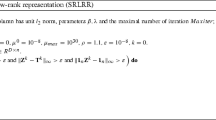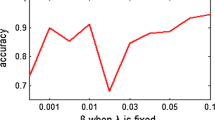Abstract
Low-rank representation (LRR) has shown its great power in subspace segmentation tasks. However, by using matrix factorization skill, fixed-rank representation dominates LRR in many subspace segmentation applications. In this paper, based on the depth analyses on fixed-rank representation (FRR), we propose a new graph-regularized FRR method which is termed adaptive graph-regularized fixed-rank representation (AGFRR). Different from the existing methods which use the original data set to build the graph regularizer for a reconstruction coefficient matrix, AGFRR uses one of the matrix factor of a reconstruction matrix to construct the graph regularizer for the reconstruction matrix itself. We claim that the constructed graph regularizer can discover the manifold structure of a given data set more faithfully. Hence, AGFRR is more suitable for revealing the nonlinear subspace structures of data sets than FRR. Moreover, an optimization algorithm for solving AGFRR problem is also provided. Finally, the subspace segmentation experiments on both synthetic and real-world data sets show that AGFRR is superior to the existing LRR and FRR-related algorithms.





Similar content being viewed by others
Notes
Other matrix norms could also be adopted. For example, \(l_{1}\)-norm \(\Vert \mathbf {E}\Vert _{1} = \sum _{i=1}^n\sum _{j=1}^n|[\mathbf {E}]_{ij}|\) and Frobenius norm \(\Vert \mathbf {E}\Vert _F=\sqrt{\sum _{i=1}^n\sum _{j=1}^n[\mathbf {E}]_{ij}^2}\). \([\mathbf {E}]_{ij}\) represents the (i, j)-th element of matrix \(\mathbf {E}\).
It also contains a sequence of 5 motions which is called “dancing”. We neglect this sub-database in our experiments.
segmentation error = 1 - segmentation accuracy.
References
Elhamifar E, Vidal R (2009) Sparse subspace clustering. Proc IEEE Conf Comput Vis Pattern Recog 2:2790–2797
Liu G, Lin Z, Yu Y (2010) Robust subspace segmentation by low-rank representation. In: Proceedings of the 27th international conference on machine learning, pp 1–8
Rao S, Tron R, Vidal R, Ma Y (2010) Motion segmentation in the presence of outlying, incomplete, or corrupted trajectories. IEEE Trans Pattern Anal Mach Intell 32(10):1832–1845
Ma Y, Derksen H, Hong W, Wright J (2007) Segmentation of multivariate mixed data via lossy coding and compression. IEEE Trans Pattern Anal Mach Intell 29(9):1546–1562
Wright J, Peng Y, Ma Y, Ganesh A, Rao S (2009) Robust principal component analysis: exact recovery of corrupted low-rank matrices by convex optimization. In: NIPS
Belhumeur P, Hespanha J, Kriegman D (2002) Eigenfaces versus fisherfaces: recognition using class specific linear projection. IEEE Trans Pattern Anal Mach Intell 19(7):711–720
Bao BK, Liu G, Xu C, Yan S (2012) Inductive robust principal component analysis. IEEE Trans Image Process 21(8):3794–3800
Vidal R, Favaro P (2014) Low rank subspace clustering (LRSC). Pattern Recognit Lett 43:47–61
Zhuang L, Gao H, Lin Z, Ma Y, Zhang X, Yu N (2012) Non-negative low rank and sparse graph for semi-supervised learning. In: CVPR, pp 2328–2335
Zheng Y, Zhang X, Yang S, Jiao L (2013) Low-rank representation with local constraint for graph construction. Neurocomputing 122:398–405
Tang K, Liu R, Zhang J (2014) Structure-constrained low-rank representation. IEEE Trans Neural Netw Learn Syst 25(12):2167–2179
Wei L, Wang X, Yin J, Wu A (2016) Spectral clustering steered low-rank representation for subspace segmentation. J Vis Commun Image Represent 38:386–395
Lu X, Wang Y, Yuan Y (2013) Graph-regularized low-rank representation for destriping of hyperspectral images. IEEE Trans Geosci Remote Sens 51(7–1):4009–4018
Yin M, Gao J, Lin Z (2015) Laplacian regularized low-rank representation and its applications. IEEE Trans Pattern Anal Mach Intell 38(3):504–517
Chen J, Yang J (2014) Robust subspace segmentation via low-rank representation. IEEE Trans Cybern 44:1432–1445
Jiang J, Yang J, Cui Y, Luo L (2015) Mixed noise removal by weighted low rank model. Neurocomputing 151:817–826
Liu G, Yan S (2011) Latent low-rank representation for subspace segmentation and feature extraction. In: ICCV
Liu R, Lin Z, Torre FDl, Su Z (2012) Fixed-rank representation for unsupervised visual learning. In: CVPR
Li P, Bu J, Xu B, He Z, Chen C, Cai D (2015) Sparse fixed-rank representation for robust visual analysis. Signal Process 110:222–231
Duda RO, Hart PE, Stork DG (2000) Pattern classification, 2nd edn. Wiley-Interscience, New York
Roweis ST, Saul LK (2000) Nonlinear dimensionality reduction by locally linear embedding. Science 290:2323–2326
Liu W, Ma X, Zhou Y, Tao D, Cheng J (2018) p-Laplacian regularization for scene recognition. IEEE Trans Cybern. https://doi.org/10.1109/TCYB.2018.2833843
Liu W, Yang X, Tao D, Cheng J, Tang Y (2018) Multiview dimension reduction via Hessian multiset canonical correlations. Inf Fus 41:119–128
Lin Z, Chen M, Wu L, Ma Y (2009) The augmented Lagrange multiplier method for exact recovery of corrupted low-rank matrices. In: UIUC, Champaign, IL, USA, Tech. Rep. UILU-ENG-09-2215
Cai JF, Candes EJ, Shen Z (2010) A singular value thresholding algorithmfor matrix completion. SIAM J Optim 4:1956–1982
Cheng B, Yang J, Yan S, Fu Y, Huang TS (2010) Learning with L1-graph for image analysis. IEEE Trans Image Process 19(4):858–866
Belkin M, Niyogi P (2003) Laplacian eigenmaps for dimensionality reduction and data representation. Neural Comput 15(6):1373–1396
Lin Z, Liu R, Su Z (2011) Linearized alternating direction method with adaptive penalty for low-rank representation. In: Taylor J, Zemel RS, Bartlett PL, Pereira FCN, Weinberger KQ (eds) Proceeding of the neural information processing systems, NIPS 2011, Granada, Spain, pp 612–620
Samaria F, Harter A (1994) Parameterisation of a stochastic model for human face identification. In: Proceedings of the 2nd IEEE workshop on applications of computer vision, pp 138–142
Jonathon Phillips P, Wechsler H, Huang J, Rauss PJ (1998) The FERET database and evaluation procedure for face-recognition algorithms. Image Vis Comput 16(5):295–306
Lee KC, Ho J, Driegman D (2005) Acquiring linear subspaces for face recognition under variable lighting. IEEE Trans Pattern Anal Mach Intell 27(5):684–698
Bartels R, Stewart G (1976) Solution of the matrix equation \(\text{ AX } + \text{ XB } = \text{ c }\). Commun ACM 19(3):275–276
Acknowledgements
Jun Yin’s Work is supported by the National Science Foundation of China (No. 61603243).
Author information
Authors and Affiliations
Corresponding author
Ethics declarations
Conflict of interest
The authors declared that we have no financial and personal relationships with other people or organizations that can inappropriately influence our work; there is no professional or other personal interest of any nature or kind in any product, service and/or company that could be construed as influencing the position presented in, or the review of, the manuscript entitled.
Additional information
Publisher's Note
Springer Nature remains neutral with regard to jurisdictional claims in published maps and institutional affiliations.
Appendix
Appendix
By following the methodology of linear ADM [28], the augmented Lagrangian function of Eq. (4) can be presented as follows:
Then the variables \(\mathbf {V}\), \(\mathbf {W}\), \(\mathbf {Z}\) and \(\mathbf {E}\) can be optimized by alternately minimizing \(\mathbf {L}\). The methods for updating \(\mathbf {V}\), \(\mathbf {W}\) and \(\mathbf {E}\) are similar to those in Algorithm 1. Hence, we focus on how to optimize \(\mathbf {Z}\) (Fig. 5).
UpdateZwith fixed other variables We abandon the irrelevant terms w.r.t \(\mathbf {Z}\) in Eq. (16), then we have
By Taking the derivative of the above problem w.r.t \(\mathbf {Z}\) and setting it to be zero, the following equation holds:
It can be seen that Eq. (18) is a Sylvester equation [32] w.r.t. \(\mathbf {Z}\), which can be solved by using the MATLAB function lyap().
Then the entire algorithmic procedure for solving Problem (4) by using linear ADM could be summarized in Algorithm 2.

Rights and permissions
About this article
Cite this article
Wei, L., Zhou, R., Zhu, C. et al. Adaptive graph-regularized fixed rank representation for subspace segmentation. Pattern Anal Applic 23, 443–453 (2020). https://doi.org/10.1007/s10044-019-00786-3
Received:
Accepted:
Published:
Issue Date:
DOI: https://doi.org/10.1007/s10044-019-00786-3




